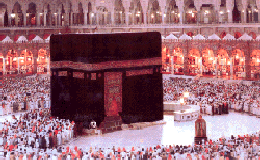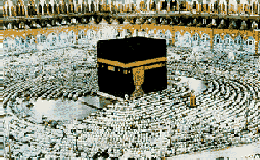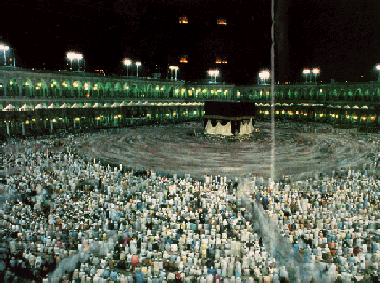REFLECTIONS FROM THE HAJJ
S. Khan and A. Zahoor
![]()
As we go around the Ka'bah or make Tawaaf (circumambulations), we know that we are walking in the same space in which the Prophet and his companions (and Prophets) walked. As we walk and run between Safa and Marwah, the two hillocks in the northeast of Ka'bah, we know these are the same hills where Hajerah (Hagar, pbuh) ran to search for water for infant Ishmael. As we drink from Zamzam, we know it is the same well that sprang up in the middle of the desert so Hagar and Ishmael could drink from it. As we gather pebbles at Muzdalfah to throw at the pillars designated as the place where Satan tempted Prophet Abraham, we realize that some of the very pebbles may have been touched by the Prophet and his companions. At this place, we are in the grip of history. We can see it, hear it, feel it, touch it and drink from it.
![]()
Between two to three million, young and old, men and women, rich and poor, black, brown and white, Asian, American and African, Arab and non-Arab, converge every year in Makkah during Zul-Hijjah the twelfth month of the Islamic calendar to perform the Hajj (pilgrimage). The Hajj is the fifth pillar of Islam. It should be performed once in a lifetime and it is mandatory on Muslims who have the financial means to travel to Makkah. The rites of the Hajj begin from the Ka'bah, the House of Allah.
Ka'bah is the first House of Allah (The One True God) built on earth. A cubic structure measuring approximately 10x12x15 meters, the Ka'bah is perhaps the smallest and the simplest religious monument ever built by man. It is located in the center of a huge mosque known as Masjid Al-Haram in Makkah (Mecca). No words can capture the majesty and grandeur of this place, that its power is beyond the power of human beings to describe. One is simply awestruck at first sight. To know this place is to understand Islam itself.
![]()
Islam's holiest place was not built by its last Prophet Muhammad (pbuh). He only cleansed it of idols and restored to its pristine status for the worship of the one true God. The tradition has it that the Ka'bah was originally built by Prophet Adam (pbuh) and was rebuilt by Prophet Ibrahim
(Abraham) and his eldest son Prophet Isma'il (Ishmael), pbut, nearly four thousand five hundred years ago.
The Qur'an 22:26-30 (Surah Al-Hajj) gives the divine command:
Prophet Muhammad (pbuh) was not the founder of Islam, only the last in the chain of Messengers beginning with Adam, Nuh (Noah), Ibrahim (Abraham), Lut (Lot), Isma'il (Ishmael), Ishaq (Isaac), Ya'qub (Jacob), Yusuf (Joseph), Ayyub (Job), Musa (Moses), Harun (Aaron), Dawood (David), Sulaiman (Solomon), Ilyas (Elias), Yunus (Jonah), Yahya (John, the Baptist), Easa (Jesus) and many others who brought the same message, i.e., submission to the one God, the Creator and Sustainer of the
universe. Therefore, Islam in essence is the oldest religion, and at the same time, in the chain of revelations, it is the youngest among the major religions of the world. The Holy Qur'an, the last revealed book of Allah, in our possession today is the same word for word as it was revealed to
Prophet Muhammad (pbuh) more than fourteen centuries ago.
As we go around the Ka'bah or make Tawaaf (circumambulations), we know that we are walking in the same space in which the Prophet and his companions (and Prophets) walked. As we walk and run between Safa and Marwah, the two hillocks in the northeast of Ka'bah, we know these are the same hills where Hajerah (Hagar, pbuh) ran to search for water for infant Ishmael. As we drink from Zamzam, we know it is the same well that sprang up in the middle of the desert so Hagar and Ishmael could drink from it. As we gather pebbles at Muzdalfah to throw at the
pillars designated as the place where Satan tempted Prophet Abraham, we realize that some of the very pebbles may have been touched by the Prophet and his companions. At this place, we are in the grip of history. We can see it, hear it, feel it, touch it and drink from it.
Since donning Ihram, the two seamless white sheets of cloth that every male pilgrim must wear instead of the regular clothing (women wear regular clothing), we have been saying Talbiah repeatedly:
Tawaaf continues day and night, come rain or sunshine, or sizzling temperatures in summer, interrupted briefly only by the five daily prayers. And Ka'bah's spiritual lines of force can be seen around the globe as Muslims throughout the world face in its direction while in prayer.
To begin Tawaaf, we must go to the Hajr-e-Aswad (Black Stone) located at the eastern corner. While the Ka'bah has been reconstructed several times, the Black Stone is physically the same stone that prophet Abraham (pbuh) placed it with his own hands. It is the only surviving stone left from the original structure of the Ka'bah. To touch and kiss the stone is to travel back in time and follow in the footsteps of all those pious and noble greats in history who have touched it. It is not easy to do that, though. It seems there are always too many people ahead who are trying to do the same. The closest we came to it was about ten feet and there we raised our hands in salutation and to say that 'God is great.' We recite suplications recommended by Prophet Muhammad (pbuh) during each circuit. After completing the Tawaaf (seven circumambulations) and praying near the 'Station of Abraham,' we drink Zamzam water before making the rounds between Safa and Marwah.
Zamzam is another living miracle. In a land where there are no rivers, this is the only aquifer that has been going on continuously for the last four thousand and five hundred years. This well has served several million pilgrims every year in the last three decades alone. The pilgrims on their return journey carry Zamzam water as a gift for their family and friends.
Next we go to Mina and after completing five prayers (Zuhr through Fajr) there, we move on to the plains of Arafat where we see multitudes of pilgrims from every corner of the globe, speaking all kinds of languages. See Makkah-Arafat map). If one is looking for an embodiment of universal human quality and brotherhood in the service of the one God, that is it. It is here that the Prophet Muhammad, Allah's blessings and peace be upon him, proclaimed the equality of mankind, justice and freedom for all in an eloquent Human Rights manifesto during his farewell Hajj:
He emphasized women's rights and demanded that husbands treat their wives with respect, kindness and gentleness and that abusing and chastising a wife is immoral. He declared economic exploitation (usury) that makes rich richer and the poor poorer as haram (forbidden). [The Last Sermon of Prophet Muhammad (pbuh)].
We pray in Arafat until dusk and then leave for Makkah via Muzdalfah and Mina. It is in Mina where Satan tempted Prophet Abraham (pbuh) and he threw pebbles at Satan to keep him at bay. In the memory of that incident, we also throw pebbles at the symbolic Satan reminding ourselves the satan within us exploiting our weaknesses and tempting us with riches, pleasures, and non-productive activities.
The most difficult time comes when leaving the House of Allah. One is never completely satisfied with the time spent here. There is always a desire for visiting it again and to enjoy the peace and tranquility of this holy place of the Prophets. We make the farewell Tawaaf and pray that we come back here soon. Ameen. While not part of the Hajj, the pilgrims are recommended to visit Masjid Nabvi in Medina, about 230 miles north of Makkah, either before or after performing the Hajj.
Copyright © 1997, 2000 S. Khan and A. Zahoor. http://www.cyberistan.org/islamic/hajjexp.htm


Muslims performing Salaat (prayers directed to Allah (SWT), The One True God) facing toward Ka'bah. LEFT: Pilgrims in standing position; RIGHT: Pilgrims in prostration. The Salaat consists of standing, bowing, prostrating and sitting positions. Before, during and after each of these positions, Muslims recite verses from the Holy Qur'an and glorify Allah as directed by Prophet Muhammad (pbuh) who was taught the details by Archangel Jibril (Gabriel, pbuh). Previous Prophets of Allah performed prayers in like manner. The small vertical enclosure to the right-front of Ka'bah is the Station of Abraham. The Hajr-e-Aswad (Black Stone in an enclosure) is seen on the nearest corner of the Ka'bah, about 4 ft. above the floor.
![]()
Behold! We gave the site to Abraham of the (Sacred) House (saying): "Associate not any thing (in worship) with Me; and sanctify My House for those who compass it round or stand up or bow or prostrate themselves (therein in prayer).
"And proclaim the Pilgrimage among men: they will come to thee on foot and (mounted) on every kind of camel lean on account of journeys through deep and distant mountain highways;
"That they may witness the benefits (provided) for them and celebrate the name of Allah through the Days appointed over the cattle which He has provided for them (for sacrifice): then eat ye thereof and feed the distressed ones in want.
"Then let them complete the rites prescribed for them perform their vows and (again) circumambulate the Ancient House."
Such (is the Pilgrimage): whoever honors the sacred rites of Allah for him it is good in the sight of his Lord. Lawful to you (for food in pilgrimage) are cattle except those mentioned to you (as exceptions): but shun the abomination of idols and shun the word that is false.Here I am O Allah, at Thy Command. Here I am, at Thy Command.
There is no partner unto Thee. Here I am, at Thy Command.
Verily Thine is the praise, the blessings and the sovereignty of the universe.
There is no partner unto Thee.![]()

Pilgrims performing Tawaaf (going around the Ka'bah, with Ka'bah to their left). Pilgrims entering for Tawaaf as indicated by radial lines (front right and left). Some are performing salaat required to complete the rites of 'Umra and others the optional salaat (prayers).
![]()
'All mankind is from Adam and Eve. An Arab has no superiority over a non-Arab. A white has no superiority over a black nor a black has any superiority over a white person, except by piety and good deeds.'
![]()
Allah: Allah is the proper name in Arabic for The One and Only God, The Creator and Sustainer of the universe. It is used by the Arab Christians and Jews for the God (Eloh-im in Hebrew; 'Allaha' in Aramaic, the mother tongue of Jesus, pbuh). The word Allah does not have a plural or gender. Allah does not have any associate or partner, and He does not beget nor was He begotten. SWT is an abbreviation of Arabic words that mean 'Glory Be To Him.'
s or pbuh: Peace Be Upon Him. This expression is used for all Prophets of Allah.
Biography • Science • Civilization • History • Andalusia • Americas • Qur'an • Muhammad • Companions • Oil • Other • Audio • Books
Image credits: Aramco World, Islamicity, Kitabul Haj, and friends.